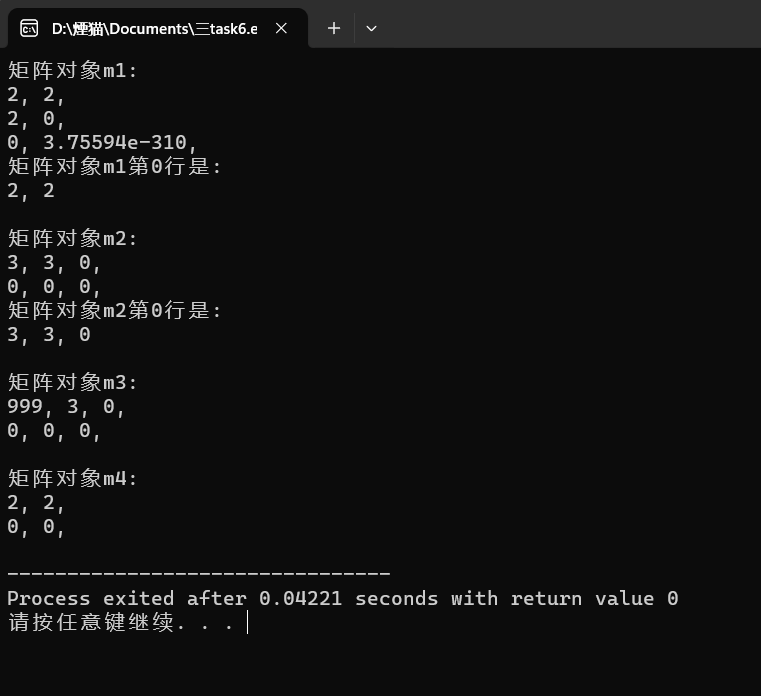Task1:
point.hpp:
#pragma once #include <iostream> using std::cout; using std::endl; class Point { public: Point(int x0 = 0, int y0 = 0); ~Point() = default; int get_x() const; int get_y() const; void show() const; void move(int new_x, int new_y); private: int x, y; }; Point::Point(int x0, int y0): x{x0}, y{y0} { } int Point::get_x() const { return x; } int Point::get_y() const { return y; } void Point::show() const { cout << "(" << x << ", " << y << ")" << endl; } void Point::move(int new_x, int new_y) { x = new_x; y = new_y; }
task1.cpp:
#include <iostream> #include "point.hpp" #include <vector> using std::vector; using std::cin; void output(const vector<Point> &v) { for(auto &t: v) t.show(); } void test() { int n; cout << "输入动态Point数组类对象中元素个数: "; cin >> n; vector<Point> x(n); cout << "x对象中所有点坐标信息: " << endl; output(x); vector<Point> y(x); cout << "\nx对象中所有点坐标信息: " << endl; output(y); cout << "\n更新x对象......" << endl; x.at(0).move(30, 50); x.push_back(Point(2, 2)); cout << "\nx对象中所有点坐标信息: " << endl; output(x); cout << "\ny对象中所有点坐标信息: " << endl; output(y); } int main() { test(); }
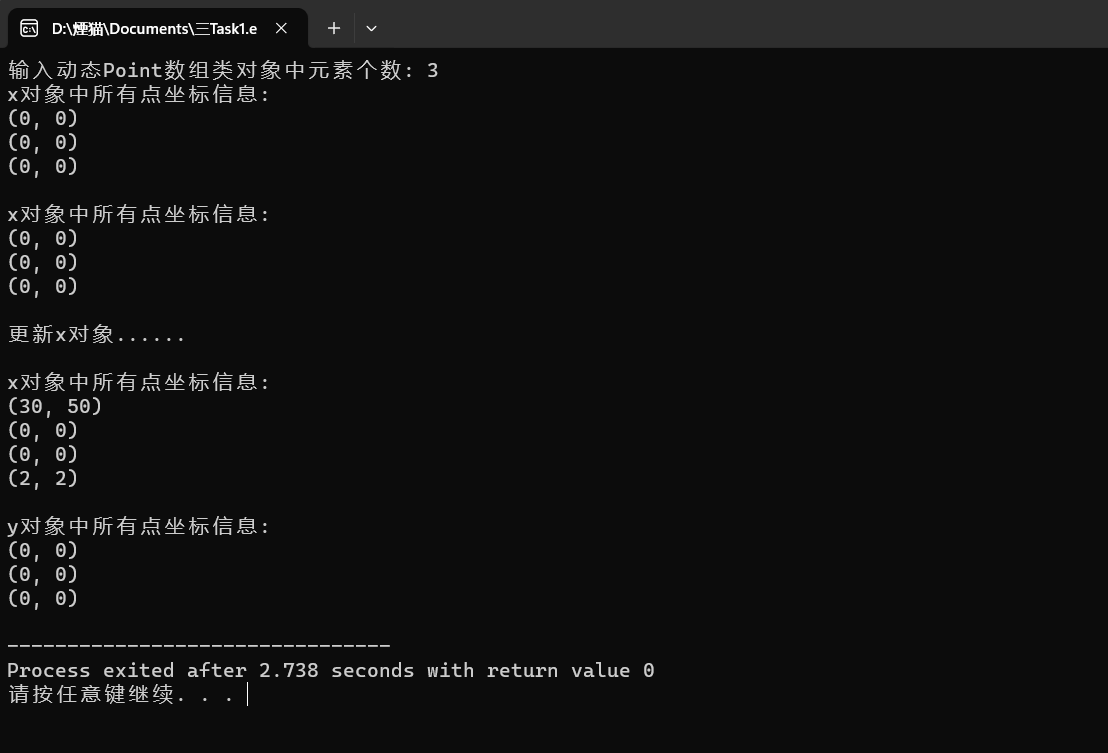
Task2:
point.hpp:
#pragma once #include <iostream> using std::cout; using std::endl; class Point { public: Point(int x0 = 0, int y0 = 0); ~Point() = default; int get_x() const; int get_y() const; void show() const; void move(int new_x, int new_y); private: int x, y; }; Point::Point(int x0, int y0): x{x0}, y{y0} { } int Point::get_x() const { return x; } int Point::get_y() const { return y; } void Point::show() const { cout << "(" << x << ", " << y << ")" << endl; } void Point::move(int new_x, int new_y) { x = new_x; y = new_y; }
task2.cpp:
#include "vectorPoint.hpp" #include <iostream> void output(const vectorPoint &v) { for(auto i = 0; i < v.get_size(); ++i) v.at(i).show(); } void test() { using namespace std; int n; cout << "输入vectorPoint对象中元素个数: "; cin >> n; vectorPoint x(n); cout << "x对象中所有点坐标信息: " << endl; output(x); vectorPoint y(x); cout << "\ny对象中所有点坐标信息: " << endl; output(y); cout << "\n更新x对象中点坐标信息......" << endl; x.at(0).move(30, 50); x.at(1).move(-1, -1); cout << "x对象中所有点坐标信息: " << endl; output(x); cout << "\ny对象中所有点坐标信息: " << endl; output(y); } int main() { test(); }
vectorPoint.hpp:
#pragma once #include "point.hpp" #include <cassert> #include <iostream> class vectorPoint{ public: vectorPoint(int n); ~vectorPoint(); int get_size() const; Point& at(int index); Point& at(int index) const; private: int size; Point *ptr; }; vectorPoint::vectorPoint(int n) : size{n} { ptr = new Point[n]; } vectorPoint::~vectorPoint() { delete[] ptr; } int vectorPoint::get_size() const { return size; } Point& vectorPoint::at(int index) { assert(index >= 0 && index < size); return ptr[index]; } Point& vectorPoint::at(int index) const { assert(index >= 0 && index < size); return ptr[index]; }
Task3:
point.hpp:
#pragma once #include <iostream> using std::cout; using std::endl; class Point { public: Point(int x0 = 0, int y0 = 0); ~Point() = default; int get_x() const; int get_y() const; void show() const; void move(int new_x, int new_y); private: int x, y; }; Point::Point(int x0, int y0): x{x0}, y{y0} { } int Point::get_x() const { return x; } int Point::get_y() const { return y; } void Point::show() const { cout << "(" << x << ", " << y << ")" << endl; } void Point::move(int new_x, int new_y) { x = new_x; y = new_y; }
task3.cpp:
#include "vectorPoint.hpp" #include <iostream> void output(const vectorPoint &v) { for(auto i = 0; i < v.get_size(); ++i) v.at(i).show(); } void test() { using namespace std; int n; cout << "输入vectorPoint对象中元素个数: "; cin >> n; vectorPoint x(n); cout << "x对象中所有点坐标信息: " << endl; output(x); vectorPoint y(x); cout << "\ny对象中所有点坐标信息: " << endl; output(y); cout << "\n更新x对象中点坐标信息......" << endl; x.at(0).move(30, 50); x.at(1).move(-1, -1); cout << "x对象中所有点坐标信息: " << endl; output(x); cout << "\ny对象中所有点坐标信息: " << endl; output(y); } int main() { test(); }
vectorPoint.hpp:
#pragma once #include "point.hpp" #include <cassert> #include <iostream> class vectorPoint{ public: vectorPoint(int n); vectorPoint(const vectorPoint &vp); ~vectorPoint(); int get_size() const; Point& at(int index); Point& at(int index) const; private: int size; Point *ptr; }; vectorPoint::vectorPoint(int n) : size{n} { ptr = new Point[n]; } vectorPoint::vectorPoint(const vectorPoint &vp): size{vp.size}, ptr{new Point[size]} { for(auto i = 0; i < size; ++i) ptr[i] = vp.ptr[i]; } vectorPoint::~vectorPoint() { delete[] ptr; } int vectorPoint::get_size() const { return size; } Point& vectorPoint::at(int index) { assert(index >= 0 && index < size); return ptr[index]; } Point& vectorPoint::at(int index) const { assert(index >= 0 && index < size); return ptr[index]; }

Task 4:
task4_1:
#include <iostream> using namespace std; void swap1(int &rx, int &ry); void swap2(int *px, int *py); void print(int x, int y); void test() { int x = 3, y = 4; print(x, y); swap1(x, y); print(x, y); cout << endl; x = 3, y = 4; print(x, y); swap2(&x, &y); print(x, y); } int main() { test(); } void swap1(int &rx, int &ry) { int t; t = rx; rx = ry; ry = t; } void swap2(int *px, int *py) { int t; t = *px; *px = *py; *py = t; } void print(int x, int y) { std::cout << "x = " << x << ", y = " << y << "\n"; }
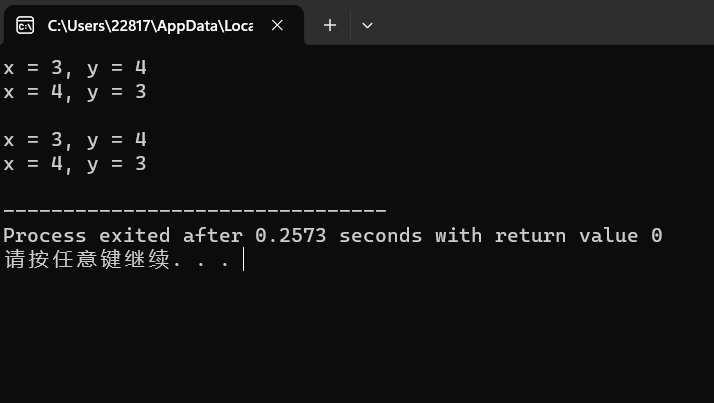
task4_2:
#include <iostream> #include <typeinfo> using namespace std; int main() { int a; int &ra = a; ra = 4; int *pa = &a; *pa = 5; cout << "&a = " << hex << &a << endl; cout << "&ra = " << hex << &ra << endl; cout << "&pa = " << hex << &pa << "\n\n"; cout << "a = " << a << endl; cout << "ra = " << a << endl; cout << "pa = " << hex << pa << endl; cout << "*pa = " << *pa << "\n\n"; cout << "type a: " << typeid(a).name() << endl; cout << "type ra: " << typeid(ra).name() << endl; cout << "type pa: " << typeid(pa).name() << endl; }
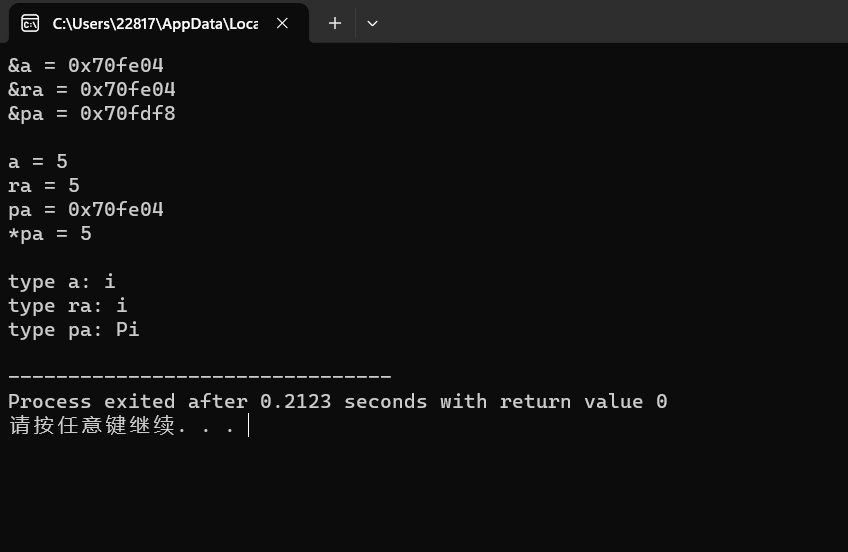
task4_3:
#include <iostream> #include <vector> using namespace std; template<typename T> void output(const T &x) { for(auto i: x) std::cout << i << ", "; std::cout << "\b\b \n"; } template<typename T> void square1(T &x) { for(auto i: x) i *= i; } template<typename T> void square2(T &x) { for(auto &i: x) i *= i; } void test1() { vector<int> x {1, 2, 3, 4, 5}; cout << "动态int型数组对象x内的元素值: "; output(x); cout << "调用函数square1()......" << endl; square1(x); cout << "动态int型数组对象x内的元素值: "; output(x); } void test2() { vector<int> x {1, 2, 3, 4, 5}; cout << "动态int型数组对象x内的元素值: "; output(x); cout << "调用函数square2()......" << endl; square2(x); cout << "动态int型数组对象x内的元素值: "; output(x); } int main() { cout << "测试1: " << endl; test1(); cout << "\n测试2: " << endl; test2(); }
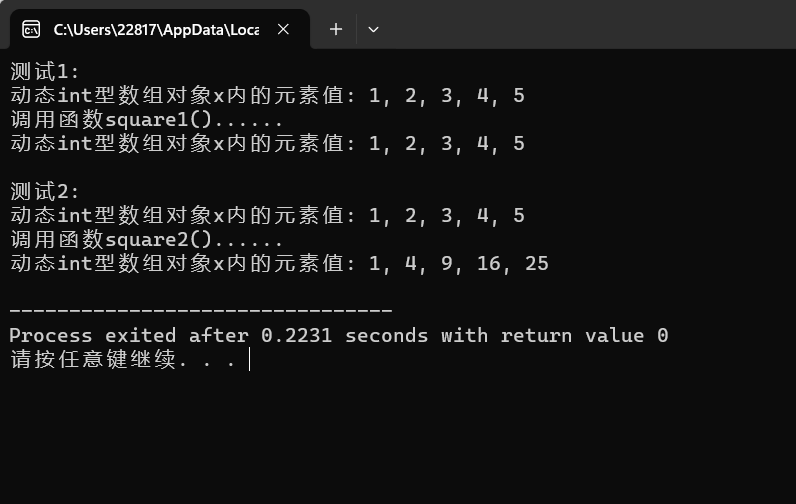
Task 5:
vectorInt.hpp:
#pragma once #include<iostream> using namespace std; class vectorInt{ private: int size; int *ptr; public: vectorInt(int n); vectorInt(int n,int value); vectorInt(const vectorInt &v); ~vectorInt(); int& at(int n); int& at(int n)const; int get_size()const; }; vectorInt::vectorInt(int n):size(n){ ptr=new int[n]; cout << "constructor vectorInt(int n) called." << endl; } vectorInt::vectorInt(int n,int value):size(n){ ptr=new int[n]; for(int i=0;i < size;i++) { ptr[i]=value; } cout << "constructor vectorInt(int n) called." << endl; } vectorInt::vectorInt(const vectorInt &v): size{v.size} { ptr = new int[size]; for(int i=0;i<size;i++) { ptr[i] = v.ptr[i]; } cout << "copy constructor called." << endl; } vectorInt::~vectorInt() { delete[] ptr; cout << "destructor called." << endl; } int& vectorInt::at(int n){ return ptr[n]; } int& vectorInt::at(int n)const{ return ptr[n]; } int vectorInt::get_size()const{ return size; }
task5.cpp:
#include "vectorInt.hpp" #include <iostream> using std::cout; using std::cin; using std::endl; void output(const vectorInt &vi) { for(auto i = 0; i < vi.get_size(); ++i) cout << vi.at(i) << ", "; cout << "\b\b \n"; } void test() { int n; cout << "输入vectorInt对象中元素个数: "; cin >> n; vectorInt x1(n); // 构造动态int数组对象x1,包含n个元素,不对元素初始化 for(auto i = 0; i < n; ++i) x1.at(i) = i*i; cout << "vectorInt对象x1: "; output(x1); vectorInt x2(n, 42); // 构造动态int数组对象x1,包含n个元素,每个元素初始值为42 cout << "vectorInt对象x2: "; output(x2); vectorInt x3(x2); // 使用x2构造x3 cout << "vectorInt对象x3: "; output(x3); cout << "更新vectorInt对象x2......\n"; x2.at(0) = 77; x2.at(1) = -999; cout << "vectorInt对象x2: "; output(x2); cout << "vectorInt对象x3: "; output(x3); } int main() { test(); }
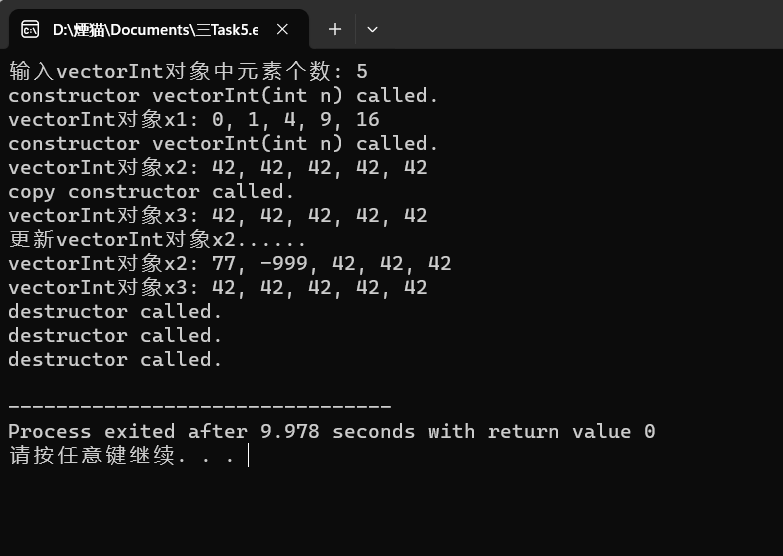
Task6:
matrix.hpp:
#pragma once #include <iostream> #include <cassert> using std::cout; using std::endl; // 类Matrix的声明 class Matrix { public: Matrix(int n, int m); // 构造函数,构造一个n*m的矩阵 Matrix(int n); // 构造函数,构造一个n*n的矩阵 Matrix(const Matrix &x); // 复制构造函数, 使用已有的矩阵X构造 ~Matrix(); void set(const double *pvalue); // 用pvalue指向的连续内存块数据按行为矩阵赋值 void set(int i, int j, double value); // 设置矩阵对象索引(i,j)的元素值为value double& at(int i, int j) const; // 返回矩阵对象索引(i,j)的元素引用 double& at(int i, int j); // 返回矩阵对象索引(i,j)的元素引用 int get_lines() const; // 返回矩阵对象行数 int get_cols() const; // 返回矩阵对象列数 void print() const; // 按行打印输出矩阵对象元素值 private: int lines; // 矩阵对象内元素行数 int cols; // 矩阵对象内元素列数 double *ptr; }; Matrix::Matrix(int n, int m): lines{n}, cols{m} { ptr = new double[lines * cols]; } Matrix::Matrix(int n): lines{n}, cols{n} { ptr = new double[lines * cols]; } Matrix::Matrix(const Matrix &x): lines{x.lines}, cols{x.cols} { ptr = new double[lines * cols]; for(int i=0;i<lines * cols;i++) { ptr[i] = x.ptr[i]; } } Matrix::~Matrix() { delete[] ptr; } void Matrix::set(const double *pvalue) { for(int i=0;i<lines;i++) { for(int j=0;j<cols;j++) ptr[i] = pvalue[j]; } } void Matrix::set(int i,int j, double value) { ptr[i * lines + j] = value; } double& Matrix::at(int i, int j) { return ptr[i * lines + j]; } double& Matrix::at(int i, int j) const { return ptr[i * lines + j]; } int Matrix::get_lines() const { return lines; } int Matrix::get_cols() const { return cols; } void Matrix::print() const { for(int i=0;i<lines; i++) { for(int j=0;j< cols;j++) { cout << ptr[cols * i + j] << ", "; } cout << endl; } }
task6.cpp:
#include <iostream> #include "matrix.hpp" using namespace std; const int N1 = 3; const int N2 = 2; // 输出一个矩阵对象中索引为index对应的行的所有元素值 void output(const Matrix &m, int index) { for(auto j = 0; j < m.get_cols(); ++j) cout << m.at(index, j) << ", "; cout << "\b\b \n"; } void test() { double x[N1*N2] = {1, 2, 3, 4, 5, 6}; Matrix m1(N1, N2); // 创建一个N1×N2矩阵 m1.set(x); // 用一维数组x的值按行为矩阵m1赋值 cout << "矩阵对象m1: " << endl; m1.print(); // 打印矩阵m1的值 cout << "矩阵对象m1第0行是: " << endl; output(m1, 0); cout << endl; Matrix m2(N2, N1); m2.set(x); cout << "矩阵对象m2: " << endl; m2.print(); cout << "矩阵对象m2第0行是: " << endl; output(m2, 0); cout << endl; Matrix m3(m2); // 用矩阵m2构造新的矩阵m3 m3.set(0, 0, 999); // 讲矩阵对象m2索引(0,0)元素设为999 cout << "矩阵对象m3:" << endl; m3.print(); cout << endl; Matrix m4(2); // 创建一个2*2矩阵对象 m4.set(x); // 用一维数组x的值按行为矩阵m4赋值 cout << "矩阵对象m4:" << endl; m4.print(); } int main() { test(); }
